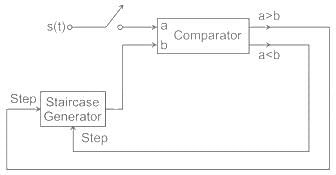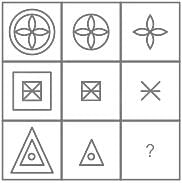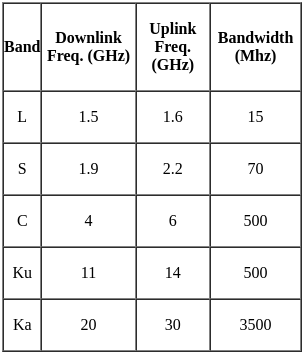BEL Trainee Engineer Electronics Mock Test - 1 - Electronics and Communication Engineering (ECE) MCQ
30 Questions MCQ Test - BEL Trainee Engineer Electronics Mock Test - 1
An IP packet has arrived with the first 8 bits as 0100 0010. Which of the following is correct?
In a semiconductor, Drift current is due to:
What will be the decimal number equivalent to the binary number (11001)2?
The energy per bit Eb of ASK, PSK and FSK follow:
In a frequency modulated (FM) system, when the audio frequency is 500 Hz and the audio frequency voltage is 2.4 V, the frequency deviation δ is 4.8 kHz. If the audio frequency voltage is now increased to 7.2 V then what is the new value of deviation?
Which of the following PCM schemes is depicted in the below figure?

The Ku frequency band used in satellite communication (for uplink and downlink) is:
Which of the following is used as a low noise amplifier in satellite receiver?
The total number of complex multiplications required for a 32- point FFT (Fast Fourier Transform) is:
Assuming zero initial conditions, the response y(t) of the system given below to a unit step input  is ____
is ____

Systems in which the output has no effect on the control action are called:
Find out the Synonym of the following word:
RECKLESS
Direction: Read the following passages carefully and answer the question that follows.
The ancient Harappan Civilization emerged, flourished and collapsed under a steadily weakening monsoon, according to new research findings, that scientists say, provide the strongest evidence yet to link its risk and fall to changing climate. A team of scientists has combined multiple sets of date to show that weakening monsoon and reduced river water initially stimulated intensive agriculture and urbanisation, but later precipitated the decline and collapse of the subcontinent's earliest cities. The scientist said their research also suggests that a larger river, summed to be the mythical Saraswati, which once watered the Harappan Civilization's heartland between the suggests it was a glacier fed river with origins in the Himalyas. The findings appear today in the US Journal Proceedings of the National Academy of Science
Q. What was the controversy in the passage?
Direction: Read the following passages carefully and answer the question that follows.
The ancient Harappan Civilization emerged, flourished and collapsed under a steadily weakening monsoon, according to new research findings, that scientists say, provide the strongest evidence yet to link its risk and fall to changing climate. A team of scientists has combined multiple sets of date to show that weakening monsoon and reduced river water initially stimulated intensive agriculture and urbanisation, but later precipitated the decline and collapse of the subcontinent's earliest cities. The scientist said their research also suggests that a larger river, summed to be the mythical Saraswati, which once watered the Harappan Civilization's heartland between the suggests it was a glacier fed river with origins in the Himalyas. The findings appear today in the US Journal Proceedings of the National Academy of Science
Q. Why the Harappan Civilisation collapsed?
By clicking on ________ folder we can retrieve the earlier email message that we work on but not yet completed or plan to send at a later time.
______ techniques can be used to resolve conflicts, such as competition for resources, and to synchronize processes so that they can cooperate.
Which of the following statement about first generation computers is false?
Which of the following includes special effects that can be applied to drawing objects?
Arrange the following words in the logical and meaningful order.
1. Designing
2. Manufacturing
3. Production
4. Planning
5. Implementation
Direction: In each of the following questions a pair of capitalised words is followed by four pair of words. You are required to mark as the answer the pair of words which have a relationship between them most similar to the relationship between the capitalised pair.
Malapropism : Words
Study the figures in given matrix and find out the answer figure which completes the problem figure matrix.



 for holes and
for holes and for electrons.
for electrons. -----(1)
-----(1)
 and energy of bit 0,
and energy of bit 0, 














 = 16 × 5 = 80
= 16 × 5 = 80




 . i.e,
. i.e,



 ⋯ (i)
⋯ (i)
















